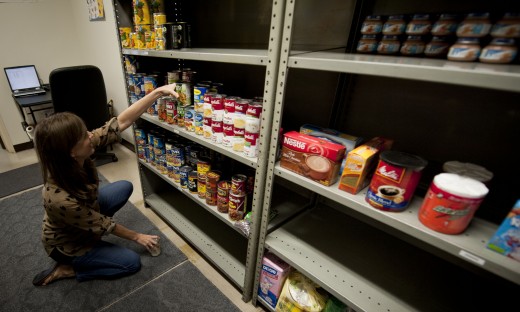Food Shortages After the Great Recession and Covid-19 Pandemic

Ohio Funding Cuts May Lead to Starvation
During the spring of 2023, Matt Habash, CEO of Ohio’s largest foodbank asked state senators to restore $15 million in annual funding that pays for food given to needy people, especially children. It was a budget cut proposed by state Republicans that many constituents strenuously opposed.
Traffic at Ohio’s food banks increased by 40% in the first half of 2023, compared to 2022, because of food cost inflation and permanent job losses during the Covid-19 pandemic. By April 2024, food bank usage had increased another 40%.
From 1995-2005, we knew from data compiled at the Private Industry Council that 34% of Ohio's children ages infant to 18 were ether receiving or eligible for food stamps. Inn 2023 that figure was down to 17% according to Feeding America, but by early 2024, the percentage increased to 34% again.
As U. S. veteran Rochelle Pate, Columbus's Food Soldier said, no one should ever have to go hungry at any time because they cannot afford food. She unfortunately did in 2023, but her staff and volunteers still hep connect Central Ohio residents to sources of food and other help.
No one should ever have to go hungry at any time because they cannot afford food.
— U. S. veteran Rochelle Pate, Columbus's Food SoldierDo We Have Enough Food?
During the Great Recession of 2008 - 2010, America seemed to run out of food in many of its food pantries and homeless shelters. Ohio has been one of the states adversely affected in this way.
Statistics from the Ohio Department of Jobs and Family Services show that during the Great Recession, 50% of Ohio families received food stamps. Further, ODJFS published data showing that from January 2004 through November 2012, the number of food stamp recipients in the state doubled i eight years.
In Ohio, Kroger Grocery Stores helped to open a new Mid-Ohio Food Bank in 2012, since the Great Recession was still hurting Central Ohioans. Local churches began to place greater efforts into stocking on-site food pantries and Vineyard Columbus church sponsored community gardens to provide produce to their own pantries and nearby food banks.



Ohio Food Shortage in its 88 Counties
Ohio has 88 counties, but not all 88 experienced a doubling in food stamp (SNAP) recipients from January 2004 through November 2012.
By end of November 2012, Ohio overall had 1,900,000 enrollees into SNAP, a 96% increase over January 2004. At the same time, seven counties experienced only a 0% to 50% in SNAP enrollments.
Many additional individuals and families accessed the food banks throughout the state, which ran out of food several times between 2009 and 2010. All our local newscasts in Central Ohio asked for food donations nightly.
Van Wert County was the county of highest increase at 218% and the only one to have an increase of over 200%, which means triple the county number of early 2004.
A total of 36 counties had an increase in up to 51% to 100% more SNAP enrollments (including Franklin County, home of the state's capital; 35 increased recipients in a range of 101 to 150%; and nine counties on the Indiana border increased recipients by 151 to 200% during the nine years examined.
There are now 49 food pantries in the Van Wert Area.
— Van Wert Ohio Financial Assistance; December 2018; Suntopia.orgWhy Is Van Wert County Different?
Van Wert County in Northwestern Ohio is just 35 miles east of the Indiana border at Fort Wayne.
At about 28,700 residents by Census2010, the largely rural area lost nearly a thousand people from 2000 through 2010. Part of this is attributed to the closure of an automotive plant across the border in Indiana, at which many Van Wert County residents had worked.
The county is a tourist draw with sites on the National Register of Historic Places:
- Brideick Lang House
- Brumback Library
- George H. Marsh Homestead
- Round Barn on US 224
- Van Wert Bandstand at the county museum
- Van Wert County Courthouse
- The county also saw some action in the American Revolution.
However, all this opportunity in the tourism industry did not offset the loss of income from the closed auto plant.
Business and Jobs
The county government offers new business heavy incentives to open there, including potentially free land in industrial parks and business districts.
As of this writing, approximately 6,500 jobs are available in the area, with an additional 5,600 job listings around Fort Wayne, Indiana.
Job listings include a fair number of registered nurses, trucking owner-operators and drivers, dental assistants, doctors, financial product salespersons, and IT- and manufacturing related Engineers. Food service job openings number about 1,000.
Many listed jobs require education beyond that possessed by the majority of adults in the county, however, according to Ohio Department of Jobs and Family Services. Transportation to Indiana jobs might be an obstacle as well.
Farmer's Markets
The county has only one farmers' market, open twice weekly on Tuesdays and Saturdays in season at 500 Fox Road in Van Wert, Ohio. Most Ohio counties have many such markets.
Between 2013 and 2018, donations to the West Ohio Food Bank in the area began to increase, with good results.
In 2016, West Ohio Food Bank provided food for 261,326 meals for its partners in Van Wert County.
— West Ohio Food Bank
Food Access Improvement in Ohio
Public Assistance rolls in Ohio for cash benefits under Ohio Works First (OWF) decreased in January 2013. Food Stamp usage increased. SNAP rolls did increase, but the total number of coupon books or Direct Cards decreased as follows, according to ODJFS statistics:
Cash Assistance
- Number of Recipients: 141,556 vs 142,270 in December 2012
- Net Payments Total: $25.9 Million vs $26.1 Million
- Average Payment per Person: $182.9/month vs $183.47/month
At the same time, the number of recipients decreased markedly in January 2013, but average payment increased by $6.00 in a year's time.
SNAP
- Number of Recipients: 242,980,19 vs 249,402,711 in December 2012 vs 252,713,612 in January 2012. That is a decrease of nearly 10,000,000 in a single year.
- Total Value of Coupons Issued: $132 vs $138.
Fiscal Year 2018
ODJFS statistics show an overall steady decrease in SNAP enrollment from 2014 through 2017, with decreases in many counties at over 25% decrease each for fiscal year 2017. Even Van Wert County experienced small decreases in enrollment.
Two counties experienced 2017 increases less than 1%: Fulton, Hardin; and two had larger increases: Darke County with a 3.65% increase and Stark County with 5.02% in 2017.
Overall, Ohio had decreased SNAP rolls markedly, partly attributable to increased food bank donations and church involvement since the Great Recession.
Interesting Non-Traditional Help
We have a number of ways to obtain food in Central Ohio, including food banks; free meals provided by numerous programs, and some cities in the state provide breakfast, lunch, and dinner almost every day. Summer lunches are provided for school-aged children at recreation centers and churches. A number of food programs involve individuals and churches as well.
Some Awesome Programs
No Chefs Allowed, unfortunately defunct, provided dinner monthly at Woodlands Tavern in Central Ohio along with music. Their website was run by two sisters willing to help the hungry with interesting food dishes. Other groups help feed the hungry and/or homeless in Central Ohio, though, including the Love Truck food truck group with Second Chance Ministries and Feed the Streets (MarShawn McCarrel at mmccarrel11@gmail.com).
Plant a Row for the Hungry: The Garden Writer’s Association suggests Americans to plant an extra row of vegetables to donate to local food banks. Food bank users are delighted to receive the fresh produce.
Star Base Columbus Annual Science Fiction Festival and Free Comic Book Day - First Saturday in May. Free admission, cash donations accepted for the Kroger/Mid-Ohio food bank.
The Food Hop: Part of the Women Who Wine on Wednesdays private Facebook group promotes events that donate 10% of wine tasting ticket prices to food banks. Participants visit a variety of places to taste wine: private homes, taverns, restaurants, and others.
Vineyard Columbus Churches: Donations to two food panties of food and volunteer hours every week, in the northeast and downtown areas of the city. Every summer, the church campuses provide volunteers to grow and harvest produce for the pantries. On a weekly basis, volunteers visit homeless camps to provide food.
A Special Scientific Program
Healthy Eating Active Living: Mapping Attributes using Participatory Photographic Surveys (HEAL MAPPS): The Ohio State University is mapping food insecurity with an eye toward helping people access fresh food every week across the state.
Food Access and Other Help
- Freshtrak.com: This site is a search engine that provides lists of food pantries, searchable by zip code.
- Kroger/Mid-Ohio Foodbank | A hunger-free and healthier community: A not-for-profit organization dedicated to feeding hungry people and increasing awareness about hunger in the community. Includes member agencies & partners.
- ODJFS Online | Office of Family Assistance: Several options besides the SNAP program are available, including lists of food banks and even farmers markets, which often have good prices and sometimes bulk rates.
- Suntopia.org | The Help You Need, When You Need It (Anywhere in the USA): Suntopia helps individuals and families find local resources for free food, utility payment and rental assistance, emergency shelter, clothing, and necessities for infants and children.
Look for similar agencies in your own area if you need help with food or want to volunteer to help others.
Sources
- CFAES College of Food, Agricultural, and Environmental Sciences at The Ohio State University. Mapping food Insecurity, Hunger in Ohio. cfaes.osu.edu/stories/mapping-food-insecurity-hunger-in-ohio Retrieved December 5, 2018.
- Ohio Department of Jobs and Family Services Statistics Archives. jfs.ohio.gov/pams/archive.stm Retrieved December 5, 2018.
- United Way of Van Wert County. www.unitedwayvanwert.org/ Retrieved December 5, 2018.
This content is accurate and true to the best of the author’s knowledge and is not meant to substitute for formal and individualized advice from a qualified professional.
© 2013 Patty Inglish MS MPH










